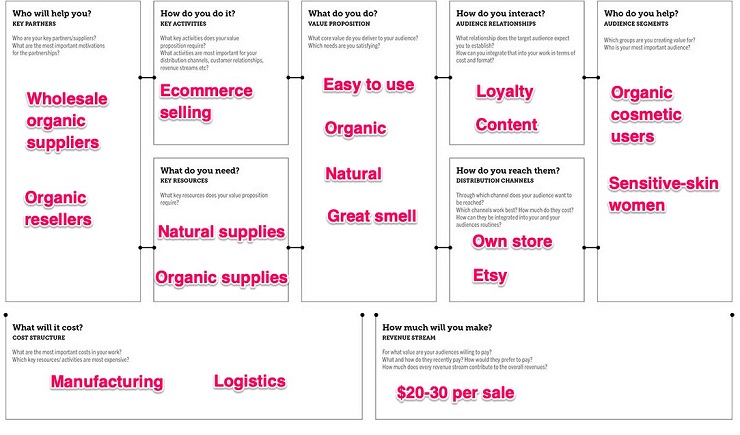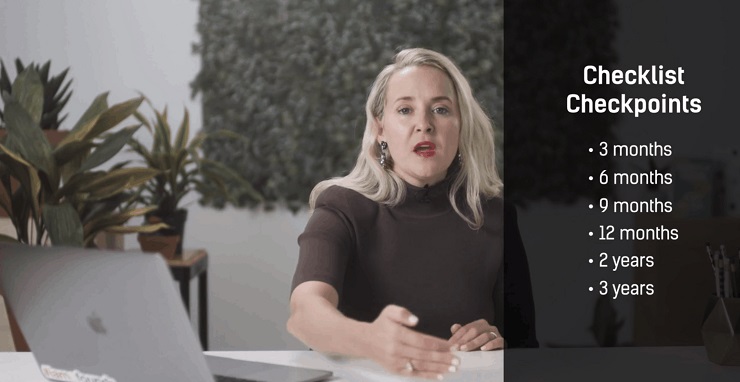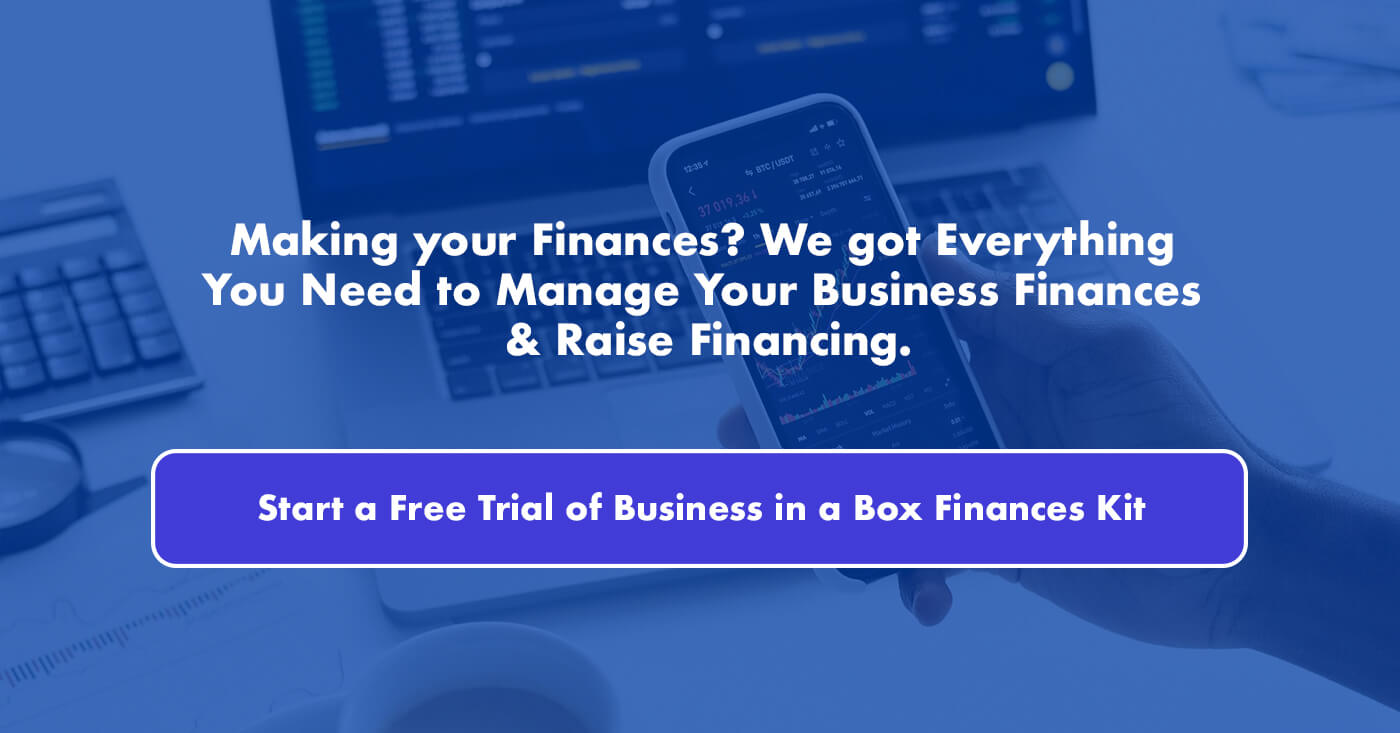Business growth doesn’t just happen on its own. It requires a long-term strategy that lays out what it will take to achieve such growth, exactly how you will pull it off, and at what cost.
That last part, the cost, is critical. Aligning a growth plan with a budget is something so many entrepreneurs struggle with.
We sat down with Alexa von Tobel, founder of LearnVest, managing partner of Inspired Capital, and author of the New York Times bestsellers Financially Fearless and Financially Forward.
In one of the many lessons, Alexa digs into this very topic. She explains that one of the most important elements to achieving long-term success is to create a three-year strategic plan, tightly coordinated with your budget.
In this plan, which she calls the “9-grid checklist,” you specify what you will do in nine areas of your business and how much each will cost you. In other words, you define what actions you can take to grow your business by assessing your resources beforehand.
Think about it as a condensed business finance plan—one that can transform the way you manage your business.
In this article, you will learn how to develop this type of financially sound plan that sets your online business on a trajectory for growth.
Why You Need to Develop Your 9-Grid Checklist
A business plan allows you to outline how your business will work—how it will make money, how it will serve its customers, and so on. But the 9-grid checklist isn’t your traditional business plan. It details the resources you are able to allocate to run your business in a specific time frame.
There are three main reasons you want to develop this checklist:
Reason 1: Prioritization
A business plan often lays out the different parts of a business, including its revenue streams, its suppliers, its marketing channels, and so on. For example, check the famous business model canvas developed by Alexander Osterwalder:

It’s a beautifully structured way to see your business from 30,000 feet. But through its simplicity, you end up with a flat image that doesn’t help you prioritize the parts of your business that matter the most and those that don’t.
The 9-grid checklist forces you to hash out your business priorities regularly, every three years. That way, you end up with a crystal clear view of what you need to focus on and in what period you must work on which components.
Reason 2: Adaptation
When starting any business, the assumptions you start with will drastically change by the time you hit the market. Not only that but the fast-paced, highly competitive environment in which most online businesses operate ends up strangling those that are unwilling to adapt.
Let’s say you run an eCommerce store selling organic and natural cosmetics. Before you open your store, your original business model may look like this:

In this case, we can see that at first, you thought that the main relationship you had to develop was through loyalty. You also thought that since your products are organic, vegan women would like to buy them. What’s more, you thought that Facebook ads were going to be one of your main costs. And the main price point was between $40 to $60 per sale.
But after a few months of having opened the business, you end up with a business model that looks more like this:

You end up realizing that content is a critical way to communicate with your customers. You also realized that vegan women don’t really care about your products—women with allergies and high sensitivity to cosmetics do. And Amazon, one of the largest platforms for many eCommerce stores, wasn’t useful—instead, Etsy ended up being a great channel.
Also, Facebook ads ended up being way too expensive and complicated, so you changed your approach. What’s more, the logistics that you thought were going to be relatively cheap were not, something that made you change your cost model.
Finally, you found out that your price point was way too high for your customer base, so you had to drop your prices a bit.
This is an extreme example—some of these changes may take years to unfold. But the point is that your assumptions will be wrong and you must adapt to these changes.
Every quarter, the 9-grid checklist helps you to go through and write what you want to accomplish in the next three years based on the circumstances that you face in the present.

Your business adapts and so does your business plan.
Reason 3: Financial Health
When you first start your online business, it’s easy to fall for lofty goals.
- You want to launch several products
- You want to expand to different international markets
- You want to sell thorough solutions at low prices
These goals, however, can overlook the financial infrastructure required. It’s great to dream, but reality will come crashing down very quickly. You need to have an air-tight budget that defines the natural constraints of your business so you can realistically grow in the shape that your resources allow you to.
You need to be aware of your limits, even though it’s not fun. This pragmatic mentality will help you grow your business on solid ground.
The 9-Grid Checklist: How It Works
Let’s take a look at what the 9-grid checklist looks like in action.

Strategy
The first part focuses on the overall business strategy. This is the big thing that you want to think about and work on in the next three to five years. It’s also the part of the grid that changes the least. You can’t obviously be changing your strategic goals every quarter or even every year.
Some potential strategies include:
- New markets to expand to
- New products or services to launch
- New customer segments to tap into
If you have a supplement eCommerce store that sells vegan protein powder, you could think about launching other vegan supplements like nutrition bars or weight gainers.
If you have a consulting business that sells marketing services, you could think about offering design services or more technical computer-based services.
These strategic objectives will take time to come into reality—and that’s exactly as they should be. You will slowly put them into place through the other buckets of this grid.
Talent and Human Resources (HR)
No matter how small or humble your business may be now if you are planning to grow into a seven- or eight-figure operation, you will need to hire people.
At first, this may not be of great importance, but the more you grow, the bigger your workload will be and the more complex your tasks will be. You will have to hire people—contractors, part-time workers, or full-time workers.
Think of this bucket not only as “human resources,” but as the talent you need to add. You don’t want a cog in your machine, but a talented person who can add both hard and soft skills to your company.
If you have a software business, you may need to hire a front-end engineer to help you expand your product. This person should have all the technical skills necessary to do the job—HTML, CSS, Javascript, etc.—but also soft skills like having a collaborative attitude, attention to detail, a proactive mentality, and more.
As you grow, you will see that the people you originally considered a perfect fit for your business may not help you grow in future stages.
- The chief marketing officer who was so good at achieving scale with a low budget might not be able to help you manage complex multi-channel campaigns.
- The operations manager who helped you organize your logistics early in your business might not be able to help you manage multiple warehouses in multiple countries.
- The designer who created your original logo and other assets might not be able to help you develop a long-standing brand.
Consider your human resources as something that expands not just horizontally by filling new positions, but also vertically, by replacing existing employees to adapt to your growth.
Financials
An often overlooked and scary-looking part for many entrepreneurs, finances are the lifeblood that makes your business run smoothly. You want to make sure that as your business grows, your finances grow with it.
This bucket helps you see whether you have any financial gaps in your business and what you can do to fill them in. It also helps you see what milestones you want to hit as your business grows.
In your first year, you may want to hit $1 million in revenue. But if you hit that milestone in the third quarter of that first year, then you may want to update that to $1.5 million or even $2 million. The same applies further down the road.
Product

The product—which can be a physical product, a piece of software, an app, or a service—is the core of your business. Your product works as an extension of your strategy. It represents your customer experience today and the way it evolves over time.
Your company may sell one or two products, or it may offer one or two core services. This bucket makes you look into the future and consider what you could add to improve your customer experience, add more value, or solve your customer’s problems more effectively.
As Alexa explains: “In your product bucket, you want to start thinking about the things that delight your customers and how those should continue to evolve over time.”
Remember, the 9-grid checklist isn’t your typical static business plan—it’s a way to structure your vision for the future.
“I always tell people: Have a big goal out there—stretch goals. As you think about the business three to five years out, get bold, get excited.”
It’s your business after all, so if you are going to grow it, you might as well do it in a way that motivates you and makes you want to work really hard to achieve your goals.
Marketing and Growth
More often than not, online business owners put most of their attention on the marketing side of things.
On the one hand, it makes sense. Without great marketing, your business won’t take off. On the other hand, entrepreneurs sometimes put their efforts into marketing because, let’s face it, there are a lot of gurus who love to sell their secret strategies for making millions online.
If all you see when you read about online entrepreneurship is online marketing, then it’s no surprise you will think about that all the time.
In the 9-grid checklist, marketing and growth is just one piece of the puzzle. It’s no more important than the other buckets in this grid. So while we can’t deny its importance, it’s not the only thing you have to think about.
The marketing and growth bucket, as Alexa put it, represents the “literal logistics of how are we going to grow.” It helps you think about the exact tactics you will use to get more customers at a lower price.
You don’t want to focus only on the typical online marketing tactics, like SEO and Facebook ads. They work, no doubt, but there are many more tactics beyond them.
Ask yourself:
- How can we get people to buy more products?
- How can we get people to buy more often?
- How can we get people to refer us to their friends?
From all of the buckets in this checklist, the marketing and growth ones will be the ones that will change the most often. You want to update your goals every quarter and come up with new ideas to test.
PR and Brand
Often considered part of the marketing strategy, PR and branding are quite different beasts from the more tactic-focused marketing bucket.
Alexa explains that this bucket helps you think about: “What does our brand want to be known for?”
In other words, how will your brand position itself in the mind of your customer? What ideas, feelings, and thoughts will arise in the minds of your customers when they think about your brand?
The branding part of this bucket focuses more on the way you present your company to the market. PR, on the other hand, focuses on the way you will get your brand to be known in the media.
PR goes beyond press releases or writing guest articles for authoritative sites. These tactics undoubtedly can work, but PR is much more than that. You want to think about what your brand does (or what it could do) to get the attention of the media.
The media doesn’t have to be CNN or some other large publication—it can be a regional, local, or industry-specific media company whose content your customers consume.
Your PR doesn’t have to be online content exclusively, either. Your PR can be distributed through videos, radio or podcasts, magazines, newspapers, and more.
This bucket can look quite intimidating and ambitious at first, but if used correctly, it can help you increase your brand’s reach exponentially.
Tech Needs
An online business isn’t your typical brick-and-mortar enterprise. Being an online entrepreneur requires you to always be thinking about ways to stay ahead of your competition and in the ever-changing virtual landscape.
In this bucket, you need to think about the ways your business can be better adapted to its technological environment.
No matter if you run an eCommerce store based on Shopify or if you are a freelancer with a simple website, you always want to have your site—your digital brick-and-mortar store—working smoothly.
Think about how you can improve your site’s speed, the quality of the online experience you provide, and the way your site converts, among other things.
Obviously, if you run a software business as Alexa did, then this bucket will be paramount for your success. Think about the bugs you may find, the speed and effectiveness of your sprints, and how you organize your projects to deploy new features, improve them, and grow faster.
Partnerships
Your business doesn’t work in isolation—you need the help of other businesses to tap into new audiences and grow faster.
That’s what this bucket is for. You want to think about how you can work with other companies and complement each other for mutual benefit.
“Think about the brands your brand wants to be associated with,” Alexa says.
Partnerships work especially well when your company is small and needs a scalable way to serve more people. These partnerships can be local or national, industry-wide, or niche-specific.
For example, if you run an eCommerce store that sells socks and other clothing accessories, you could partner with larger clothing brands that could offer your products and vice-versa.
You could also partner with other clothing accessory brands that don’t sell the products you sell or serve the same audience as your company. So if your brand is focused on young women, you could partner with a similar brand that targets wealthy older customers.
Milestones
“In this bucket, I want you to think about how many customers you have, the revenue you generate, your ratings—anything that you quantify.”
You want to determine very specific milestones for each of these metrics and organize your growth towards them.
If your business generates $10,000 a month, a milestone could be to hit $15,000 in the next quarter, $50,000 in one year, and $500,000 in three years.
These milestones are very personal—they relate to whatever your company’s goals are. If you want to focus exclusively on revenue growth, then that should be your main milestone. But if there are other areas where you see your business is lagging, focus on those as well.
Putting Everything Together

As you put this checklist together, you will start to wonder where these buckets tie together with your budget.
While most of these buckets don’t have an explicit monetary component they will help you visualize what you need to do and how much it will cost you to hit each target for each bucket.
The 9-grid checklist isn’t about listing goals for each area and hoping for the best. It’s a systematic way of being aware of your goals and targets for each area and determining what it will cost you to achieve them.
“This work directly translates to what you are going to put in your financial model as you think about the who—the people you need to hire—the what—the money you need to spend in any of these initiatives—and it will help you to get really clear as you think on your financial plan.”
At first, you want to work on your checklist every quarter. As your business grows, you’ll want to work on this twice a year or annually.
Take the time to develop your own 9-grid checklist. Remember the saying: “failing to plan is planning to fail.”
Plan your checklist and start to work on the future of your online business.
If you are interested in learning more about how to plan your finances and build a solid foundation for your online business’s success, check out our Financial Kit “Finance for Founders.”
Source: Foundr.com
























